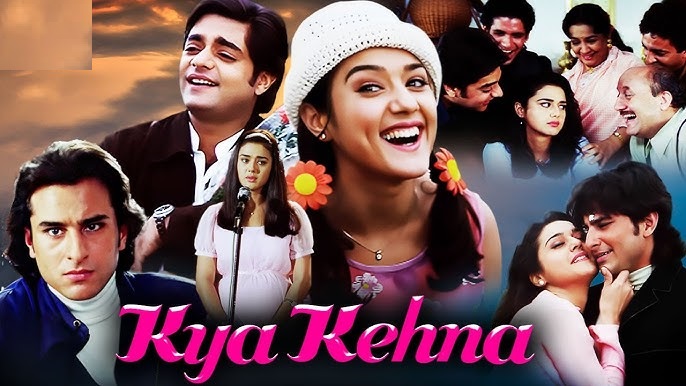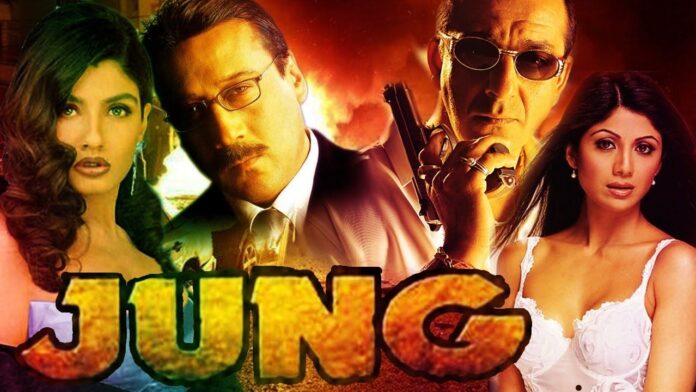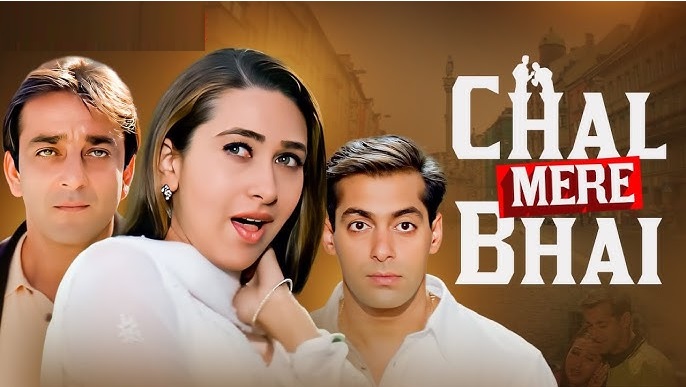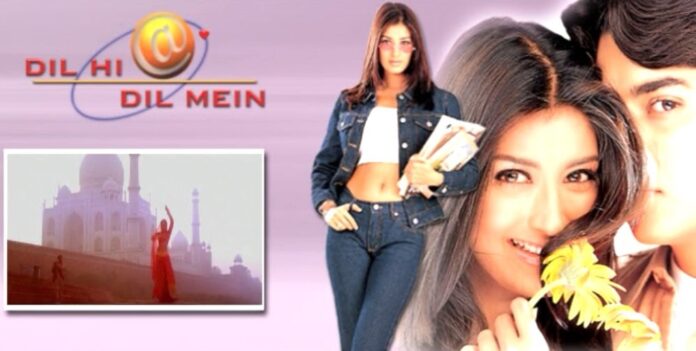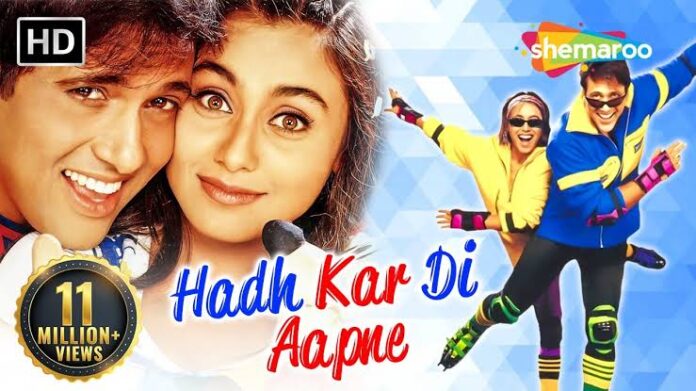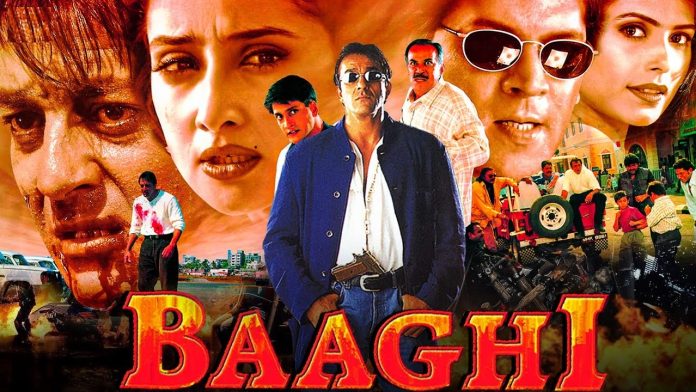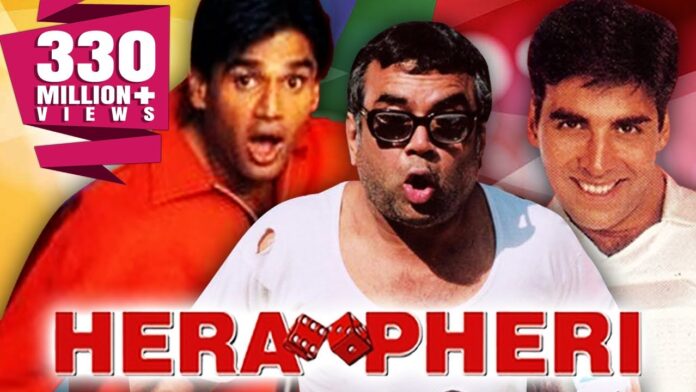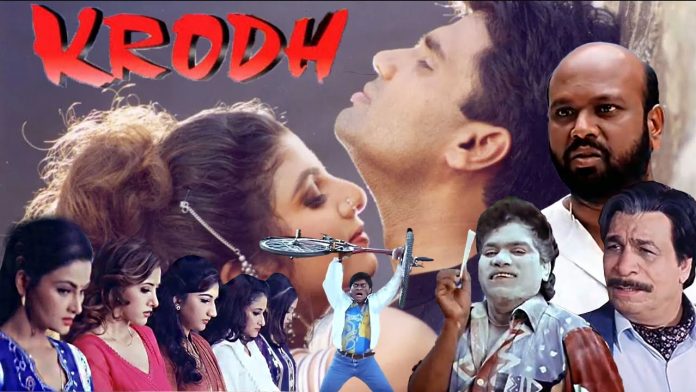KYA KEHNA!
Tips Films’ Kya Kehna! is an unusual and bold story of an unwed mother. A young happy-go-lucky girl from a decent family is fooled by a college boy into believing that he is very straightforward when actually he is a flirt and a womaniser. She falls in love with him and he seizes the opportunity to impregnate her but once that is done, he refuses to get tied down to her by marriage. He agrees that the child in her womb is his, but simply turns down her family’s proposal for marriage. Rather than abort the child, the girl decides to give birth to it, and for this, she first fights with her family and then, once the family sees reason in her argument, she stoically faces the world which pokes fun at her. Ultimately, she manages to emotionally move the boy responsible for her miseries. He even asks for her hand in marriage but by then, a childhood friend has also stepped in and is ready to give his name to the child who is about to be born. How the bold mother-to-be chooses between the two boys forms the climax.
For its very content (writer: Honey Irani), the film has immense appeal for ladies. Although the conviction in the story is not strong enough to create a long-lasting impact, the novelty, nevertheless, appeals to the audience. The portion in which the girl’s family members miss her, after she is thrown out by her father, is heart-rending. The scene in which she is actually thrown out may look unrealistic to the big-city audience but will evoke sympathy of the cinegoers in non-metropolitan cities. The girl’s speech on her college annual day should have been more forceful; it is, however, emotional enough to get the audience on her side. The flirtatious boy is shown as a grey character when a black character was the demand. Again, the climax is a bit tame. A bold story like this particular one required a climax full of drama and histrionics. Dialogues are fairly good.
Preity Zinta acts quite well and is greatly aided by an author-backed and meaty role. She manages to evoke sympathy for her character, at times. She, however, leaves something to be desired in the pre-climax and climax scenes. Saif Ali Khan acts well but does not consistently look good. Chandrachur Singh gets less scope and is just about average. Anupam Kher puts in a sincere performance and shines as Preity’s father. Farida Jalal is very good, as usual. Mamik does an able job. Navneet Nishan could have done much better. Puneet (as Preity’s second brother) is effective. Amit (as the youngest brother) is wonderful. Nivedita, as Mamik’s wife, is alright. Reeta Bhaduri, Rajiv Verma and Vikas Anand lend average support. Deven Varma and Daisy Irani are hardly funny!
Director Kundan Shah’s handling of the bold subject is quite good. He manages to keep the drama interesting all through. Music (Rajesh Roshan) is extremely good. The title song is a hit number and it has been used in happy and sad versions very appropriately. ‘Jaaneman jaane jaan’, ‘O Soniye’, ‘Pyara bhaiya’ and ‘Dekhiye aji jaaneman’ are also appealing songs. Camerawork (Rajesh Joshi) is of a good standard. Background score is effective.
On the whole, Kya Kehna!, an emotional fare for women, will click for its novel and bold theme. Should prove class A in some circuits.
Released on 19-5-2000 at Liberty and 9 other cinemas of Bombay by Tips Films Pvt. Ltd. thru R.G. International. Publicity: extraordinary. Opening: excellent. …….Also released all over. Opening was superb almost everywhere.
LATEST POSITION
Heavy rains in Bombay on Thursday adversely affected box-office collections. …The excellent opening response to KYA KEHNA! has emphasised the fact that appropriate and enthusiastic promotion helps and how!
Jung has not found appreciation. Is a plus fare in East Punjab because of the excellent opening last week. It, however, dropped midweek even in Punjab. 1st week Bombay 56,27,531 (80%) from 13 cinemas (8 on F.H.); Ahmedabad 11,73,875 from 5 cinemas (1 in daily 2 shows), Baroda (28 shows) 1,84,609, Vapi 4,89,350 from 2 cinemas; Pune 12,49,029 from 7 cinemas (1 in matinee), Solapur 2,82,337 from 3 cinemas (1 in matinee), Sangli 1,69,464 from 2 cinemas (1 in matinee); Hubli 83,265, Belgaum 98,384, Dharwad 57,628; Delhi 26,67,307 (41.65%) from 13 cinemas (1 on F.H.); Kanpur 3,46,481 from 2 cinemas, Lucknow 2,81,804, Agra 2,25,000, Varanasi 3,15,885 from 2 cinemas, Allahabad 1,85,000, Bareilly (6 days) 1,30,488; Calcutta 20,63,010 from 21 cinemas; Jabalpur 1,52,786, Amravati (6 days) 2,01,692, Raipur 1,11,839, Bhilai (6 days) 81,2444, Jalgaon 2,09,541, Yavatmal 51,168; Indore 2,13,769 from 2 cinemas (3 on F.H.), Bhopal 1,26,859 from 2 cinemas (1 unrecd.); Jaipur (29 shows) 5,57,781 from 4 cinemas; Hyderabad (gross) 25,13,085 from 10 cinemas; Bangalore (nett) 2,79,282; Guntur (gross) 87,532.
……….
Chal Mere Bhai nosedives (drops by 50% in most of the cinemas) and falls flat. 2nd week Bombay 39,94,447 (65%) from 11 cinemas (9 on F.H.); Ahmedabad 10,79,997 from 6 cinemas (1 unrecd.), Vapi 1,61,145, Rajkot 1,57,800 (1 in matinee unrecd.), Jamnagar 50,300 (1 in matinee unrecd.); Pune 9,20,759 from 5 cinemas (1 in matinee), Solapur 1,83,446; Delhi 17,31,583 from 9 cinemas (2 on F.H.); Kanpur 2,18,401 from 2 cinemas, Lucknow 3,78,127, Agra 2,60,000 Varanasi 1,25,628, Allahabad 70,651, Bareilly 91,181 (1st 1,72,937), Hardwar 30,000; Calcutta 5,12,083 from 2 cinemas; Amravati (6 days) 1,39,045, Akola 1,56,590, total 3,62,197, Raipur (gross) 2,55,377 (1st 3,93,475), Durg 58,141 (1st 1,21,727), Jalgaon 1,14,478 (1st 2,18,786), Wardha 37,845, Yavatmal (last) 58,183 (1st 1,57,114), Bilaspur 83,240 (1st 1,74,202); Jaipur 1,68,926.
Kaho Naa…Pyaar Hai 18th week Bombay 6,92,011 (51.51%) from 3 cinemas (4 on F.H.); Ahmedabad 5,40,186 from 3 cinemas, Baroda (28 shows) 1,75,246; Pune 3,47,061 from 2 cinemas (1 in matinee), Solapur 1,13,496; Delhi 4,73,582 from 4 cinemas; Lucknow 1,75,173, Agra 62,000, Varanasi 91,139, Allahabad 53,918; Calcutta 2,87,679 from 3 cinemas; Jabalpur 92,746 (17th 92,394), total 22,36,806, Amravati 86,550, Akola 94,982, total 21,91,388, Raipur 75,000, total 22,04,915, 3rd week Bhilai (6 days) 32,290, 1st week Karanja 1,02,276, 18th Jalgaon 72,358 (17th 71,038), 13th week Wardha 37,948, 17th week Chandrapur 85,493, total 22,72,659; 18th week Bhopal 1,09,816; 18th combined week Jaipur 60,123; Hyderabad (gross) 4,46,477 from 2 cinemas.
PADMALAYA TO GO INTO ACTION IN HOLLYWOOD
Hyderabad-based Padmalaya Telefilms Ltd., a division of Padmalaya Films, has plans to enter the US film industry to produce action movies on the lines of Broken Arrow and Speed.
The entry of Jackie Chan into the US movie market has prompted Padmalaya to venture into Hollywood. Padmalaya is deciding whether to have co-production tie-ups with US production houses or enter the market directly.
Padmalaya will not utilise services of Indian actors but will recruit stars like Arnold Sachwarzenegger and Sharon Stone.
G.V. Narasimha Rao, Padmalaya’s company director and operations in-charge, said that it will leverage its strength from its experience of producing over 60 films in India under the Padmalaya banner.
The company will tap the market with an equity issue which is scheduled to open on May 31. In recent times, German film production houses also have stormed Hollywood. In addition to producing action movies for the global audience, Padmalaya will produce a mega film for a global production house, using its animation and design shop base.
The company, founded by Telugu film superstar Krishna, is entering the capital market with an issue of 25 lakh equity shares of Rs. 10 each at a cash premium of Rs. 90, aggregating Rs. 25 crore. The shares are proposed to be listed on the Bombay and Hyderabad stock exchanges.
The proceeds will be used to set up joint ventures and studios, expand the company’s marketing networks and procure films for its library.
Padmalaya has tied up with indiainfo.com for creation of web ads for its portals, and with In-House Productions Ltd. for marketing television software.
GRAND OPENING FOR RAJHANS CINEMA IN SURAT
Rajhans Cinema in Surat was inaugurated on the auspicious Buddha Poornima day (18th May). The opening was very largely attended and was a grand affair. From Bombay, those who attended the cinema inauguration were U.A. Thadani, N.N. Sippy, Shyam Shroff, Balkrishna Shroff, Devendra Shah, Inder Raj Kapoor, Kantibhai (Rajshri), Pinky Badlani and Sanjay Chaturvedi. Ramesh Sippy, Rakesh Sippy, Haresh Bhatia and Raj Lalchandani were also scheduled to attend, but they could not reach in time to board the train to Surat, owing to a torrential downpour on 18th in Bombay. Haresh Lakhani and Ramesh Lakhani of Sagar Talkies, Baroda, and Mahendrabhai of Gopi Cinema, Anand also attended.
Jayesh Desai and Sanjay, the two owners of the new cinema, played perfect hosts. The cinema was thrown open to the public from 19th. Kya Kehna! is the opening attraction.
SAJJAN PASSES AWAY
Veteran actor Sajjan passed away in Bombay on 15th May following cardiac arrest. He was 80 and is survived by his wife, three sons and two daughters.
Sajjan came to films via theatre as he was a dramatist. He joined Prithvi Theatres and shot into prominence after playing the role of Mohammed Ali Jinnah in the stage play ‘Deewar’. He played the hero’s role in a number of films including Saiyan (opposite Madhubala) and Sheesha (opposite Nargis). Notable among the 200 films he acted in are Hum Log, Muqaddar, Najaria, Neelampari, Poonam, Nirmohi, Toofan, Bandish, Parichay, Johny Mera Naam, Dil Diya Dard Liya, Amir Garib and Chalti Ka Naam Gaadi. He had also acted in some teleserials like Vikram Vetal.
Former FWICE president Chandrashekhar described Sajjan as the main pillar of the Cine Aritstes’ Association. Sajjan was also a poet and he wrote the popular non-film song of yesteryears, Mera pyar mujhe lauta do. He was very fond of appearing in different get-ups and he once played eight roles in a single drama.
DO YOU KNOW?
* Calcutta has shifted to Bombay! Not metaphorically, but cinematically. Producer Salim’s bilingual — MITTI (Hindi) and OH CALCUTTA (English) — is being shot in a Calcutta basti set put up at Chandivali Studios. The authentic set has been created by art director R. Varman.
* SHABDAVEDI (Kannada) is celebrating 100 days in 18 cinemas in Karnataka. From Bombay-Karnataka alone, it has yielded a share of 34.17 lakh!
FIRST TIME EVER
* KAHO NAA…PYAAR HAI is poised to write history in Wardha at Durga Talkies. It is the first ever film which will celebrate 100 days at Wardha! The film, running in its 14th week now, has consistently been creating record week after week. It will complete 100 days next week. The cinema was started in 1947.
YOU ASKED IT
Why is it that only Gujarat has multiplexes coming up in the state?
– Because it is the Gujarat government which has formulated a policy for new multiplexes. The Maharashtra government’s policy is still to be gazetted though more than a year has elapsed since it was formulated. But Rajasthan is another state which has a policy for multiplexes and, therefore, some cineplexes are coming up in that state too.
Most of the big, star-cast films get huge monies for Overseas, satellite and music rights. When their recoveries from the above three are big, why can’t producers of such films sell the territorial rights of India at more reasonable prices?
– Wish, all producers thought like you. But the fact is that everybody wants to become cash-rich/cash-richer/cash-richest.
Is it true that Sunny Deol is not acting in Rajkumar Santoshi’s Lajja?
– Yes, Sunny is not acting in LAJJA… Kareena Kapoor, too, is not in Sanjay Tolani and Rajiv Tolani’s untitled film, being directed by Raj Kanwar. A new heroine is being finalised.
3-E
Education-Entertainment-Enlightenment
Shah Rukh Versus Hrithik: The Diwali Dhamakas
If the release schedules are anything to go by, there’ll be fireworks of a different kind this Diwali. Yash Chopra’s Mohabbatein, starring Shah Rukh Khan, and Vinod Chopra’s Mission Kashmir, starring Hrithik Roshan, are both scheduled for release on Diwali. There are clearly two camps in the industry — one which swears, Shah Rukh is still no. 1, and the other which feels Hrithik is the new numero uno. Both these camps will keenly watch the opening response to the two films and then, the debate about who is no. 1 will gather more ground. As in the trade, there’s divided opinion among the public too. Nobody is prepared to believe — and sadly so — that both, Shah Rukh and Hrithik, can and actually will co-exist. And like this Diwali, there’ll be fireworks on the Diwali of 2001 too. But next year, there won’t be two releases of the two stars. They will be seen together in the same film. Yes, Karan Johar’s Kabhi Khushi Kabhi Gham, starring Shah Rukh and Hrithik (besides, Amitabh, Jaya Bachchan, Kajol and Kareena Kapoor) will be released on Diwali 2001.
Cover Boy Hrithik!
Stars making it to covers of glossies is old hat. But what is new — and news — is that Hrithik Roshan has been featured on the covers of notebooks of students! Subhash Sharma, who was at one time a film producer (he had co-produced Suhaag, directed by Manmohan Desai), has, along with Amrut Shah of Sundaram Multi Pap. Ltd., has introduced long notebooks with an autographed Hrithik photograph on the cover. The 192-page notebooks, priced at Rs. 19, have a brochure and a fan club card. The back cover of the notebook has photographs of Hrithik in different poses and a ‘good thought’ signed by the star. There’s also information about Hrithik’s birth date (January 10), his height (6 feet), age (25), the name of his school and college, where he can be contacted on the website, and his fanmail address. The book printers should have been thoughtful enough to add a line or two from Hrithik on the notebook, exhorting the students to study hard. That actually should have been Hrithik’s ‘good thought’.
Lakhani’s Confidence: Wah! Kya Kehna!!
Haresh Lakhani of Sagar Cinema, Baroda, was, perhaps, the only person in the trade who was supremely confident that Kya Kehna! would take a bumper start. Despite two weak heroes in the film, his confidence was born out of the audience response to the film’s theatrical trailer and also out of the brilliant publicity done by Tips, on satellite channels. Not just that, Lakhani was also ready to put his money where his mouth was as he even offered to buy its sub-distribution rights for Gujarat from Bombay distributor U.A. Thadani; but the latter refused to sell the rights. Anyway, Lakhani booked the film as the opening attraction at the new Rajhans cinema in Surat. Says Lakhani, “People laughed at me when I booked Kya Kehna! at Rajhans, but today, with my stand vindicated, I am having the last laugh.” And rightly so.
Who Is The Hero?
There is an unwritten law in the industry that it is the heroes who command an initial for the film; however popular a heroine, she cannot attract the audience to the cinemas on day one. But this week’s release, Kya Kehna!, has opened to excellent houses despite the presence of two heroes (Saif Ali Khan and Chandrachur Singh) who are far from ‘hot’ among the audience. So, is Preity Zinta the real hero of the film? While Kya Kehna! has definitely broken the myth that only heroes can command a good opening, it would be wrong to give the entire credit to heroine Preity Zinta for the stupendous start to Kya Kehna!. Actually, the major credit should go to producers Ramesh and Kumar Taurani for their brilliant publicity, trailers and promotion of the film. Rajesh Roshan’s music, especially the title song, also helped. It would not be out of place to mention here that even after the super-success of Nagina, Sridevi’s Sherni had opened to poor houses.
Downpour Not A Dampener
Bombay distributors and exhibitors will not forget the inauguration of Rajhans cinema in Surat for a long time to come. Those who attended its opening will not forget it for the manner in which they made it to the railway station in Bombay to take the train to Surat on the afternoon of 18th May. And those who could not attend its opening will remember it for the efforts they made to board the train but couldn’t. Life in Bombay was thrown completely out of gear on 18th due to heavy rains, flooding and water clogging. Train services were disrupted and road traffic moved at a snail’s pace in many parts of the city. To make matters worse, the Karnavati Express train, on which the invitees from Bombay were booked, left from Borivli station instead of Bombay central station as usual. Most of those who had to travel, had almost reached Bombay Central when they learnt of the rescheduling of the train. With local train services discontinued around that time, the only alternative was to reach Borivli, about 40 kilometres away, by road. While Pinky Badlani and Sanjay Chaturvedi managed to reach Borivli in time for the Karnavati Express, Ramesh Lakhani (of Baroda), who had all the tickets with him, could not reach in time. As a result, Badlani and Chaturvedi had to buy fresh tickets. As for Ramesh Lakhani, none of the 21 tickets he had for Karnavati could be used! He along with U.A. Thadani, N.N. Sippy, Inder Raj Kapoor and Kantibhai travelled to Surat in another train. Shyam Shroff, Balkrishna Shroff and Devendra Shah had fortunately gone to Surat earlier that day and, therefore, did not have to face nature’s fury in Bombay. Ramesh Sippy and his son, Rakesh Sippy, as also Komal Nahta reached Bombay Central with great efforts, but could not make it to Borivli station. Haresh Bhatia and Raj Lalchandani also missed the train — and, therefore, the grand opening.
‘Khud Butter Chicken Khayega Aur…”
An exhibitor of Moradabad and Bareilly (U.P.) had booked a recently-released film at his two cinemas by paying handsome MGs to the film’s Delhi-U.P. distributor. The exhibitor had reposed complete faith on the film’s director. So, when the film fared dismally, much to his shock, the exhibitor reacted by saying, “I never curse anybody, but I am making an exception now. I curse this director with all my heart. He has not only made an inferior film but he has also made an incomplete film (‘incomplete’, meaning without a proper climax). Yeh khud toh butter chicken khayega aur hamaari dal-roti chheen-ne chala hai.” The outburst was an expression of the exhibitor’s heartburn and revealed the extent to which he had burnt his fingers!
The Hrithik Quake!
TREMORS IN CITY PULSE
KOMAL NAHTA
What happens at Bombay’s Santacruz airport is just a curtain-raiser to what is to happen at Ahmedabad’s Vallabhbhai Patel airport an hour later. The ground hostesses of Jet Airways are fighting over who would escort Hrithik Roshan to the security check. The security guys pretend to be more restrained than their excitement can permit them — they are, perhaps, thinking of the stories they would narrate to their kids at home, of Hrithik, the heartthrob of generation today. The co-passengers can’t believe their eyes and luck. Is it Hrithk they are seeing in their midst? Is it the Hrithik? Autograph seekers rush to the new icon with whatever pieces of paper they can lay their hands on, for the signature that could be worth more than Rs. 2 crore in the film industry. After all, Hrithik Roshan’s debut film, Kaho Naa…Pyaar Hai, has hit pay dirt. In fact, it is for the 100 days’ celebration of the film that Hrithik and dad Rakesh Roshan, the producer and director of the biggest hit of the year so far, are flying to Ahmedabad on 14th May. The celebrations are scheduled for the evening at one of India’s best cinemas — the City Pulse multiplex in Gandhinagar, the capital of Gujarat.
On the flight, star-struck stewards and high-on-Hrithik hostesses go through the routine of serving refreshments to the passengers with alarming speed. For, they have a more important job on hand — to take Hrithik’s autograph for themselves, family members, friends, distant relatives, may be, even foes! To the air staff’s good fortune, physique-conscious Hrithik chooses not to eat or drink anything on flight and utilises all of the 50 minutes to sign autographs and chat with them.
Thousands of eager spectators have dotted the airport boundary to have a look at the hero long before the flight touches base. Sensing the mob excitement, Ashok Purohit, the owner of City Pulse, and his family have very thoughtfully arranged for a car to pick up the Roshans from the tarmac itself. The cool drive to the hotel, close to the airport, is a welcome change after the initial 15 minutes of the flight when the cooling system had failed. Hrithik had used the menu card to fan himself even as fans of all age groups in the aeroplane fanned his ego.
The scene in the hotel lobby is equally crazy. Young girls and boys, with their mothers and fathers in tow, let out shrieks of joy as Hrithik descends from the car. One little boy is heard chanting, “Hrithik….. O mummy….. O mummy…..,” clutching his sister’s hand tight lest he faint. The one-film hero waves out to the crowds, shakes hands with some of them and takes the elevator to his spacious suite on the second floor of the hotel. Papa Roshan complains playfully, “Previously, at least some people used to ask me for my autograph. Now, once they get Hrithik’s autograph, they don’t even bother about mine.” Of course, the well-meaning pride in papa’s voice is there for all to see. Then Roshan Sr. goes on to relate an incident that had taken place at the friendly cricket match between Sachin Tendulkar XI and Hrithik XI the previous day in Bombay. A little boy, barely four years old, unable to reach Hrithik Roshan for an autograph, had pushed his autograph book into Rakesh Roshan’s hand and pleaded, “Uncle, please sign Hrithik Roshan!”
Before the star and star-maker zip off to City Pulse to make an appearance in all the three cinemas in the multiplex, Ashok Purohit and his wife feed them with figures over tea and biscuits. Hrithik orders for sandwiches as Purohit announces that KN…PH has already grossed Rs. 65 lakh in 17 weeks at City Pulse alone. “My desire is to touch Rs. 1 crore mark on the silver jubilee of the film,” says Purohit to the beaming Roshans. Incidentally, this is the highest collection a single film has grossed in the year-long history of City Pulse which opened in May ’99. It may not be possible to add another Rs. 35 lakh in 8 weeks to reach the target set by Purohit, but it would still remain the highest grossing film so far at the multiplex.
Hrithik informs about his portal which father-in-law-to-be, Sanjay Khan, plans to launch. “It will take some time to be launched, may be four or five months because I’ve got to sit and understand the whole thing,” he explains. But will the busier-than-the-proverbial-bee actor find time for all this even as every producer and director worth his name in the industry approaches the Roshans with a script that’s “written only for Hrithik”? The teenage sensation answers that indirectly when he reveals later, in reply to a question whether girlfriend Suzanne gets disturbed by the unprecedented female adulation that’s come his way. “She is not disturbed by the female fan-following but she definitely gets disturbed because I don’t get any time for her,” he reveals. “She comes to meet me at the gym at night when I am working out. That’s the only time we get to see each other.” He pauses for a while and then rues, “What a place to meet, no, the gym?” When will the wedding bells chime to the breaking of millions of hearts? Hrithik is more honest when confronted with this question on a one-to-one basis than when the same question is thrown at him at a press meet in Ahmedabad, with dad seated next to him. Perhaps, his embarrassment because of his father’s presence by his side makes him mumble at the press conference, “Married, I will definitely get, but not now.” The same question gets a more specific reply when dad is not within hearing distance. “Marriage will be some time next year,” blushes the very-much-in-love Hrithik.
Back to Kaho Naa…Pyaar Hai and the crowds of the capital city of Gujarat. There’s heavy security at City Pulse pulsating to the beat of Hrithik mania. It’s 9.30 p.m. but the crowds, mostly comprising youngsters, refuse to take their seats in the three halls, all screening KN…PH. Today, they’ve come to see Hrithik, not the film. They want to see him in flesh and blood, they want to touch him, they want to see how much like them he is, they want to see how he walks and talks in real life. They want to get a darshan of their new God! The City Pulse management, in a bid to bring about a semblance of discipline, announces that Hrithik will not make an appearance unless the audience take their seats. Shouts of “Oh no!” rent the air but the well-behaved crowds take the hint — and their seats too. The film show begins. There’s an excited and palpable restlessness in all the three halls. Outside, in the foyer and the huge compound leading to it, there’s an air of festivity. Even the live band that plays in the compound every weekend evening is more charged this particular evening.
And then… and then… the unbelievable happens. Hrithik and Rakesh Roshan arrive at City Pulse. Coming out of the car, they make their way into the first cinema amidst tight security. Young girls and boys can’t believe their eyes when they see their idol! Mothers rush out to reach Hrithik in the auditorium, not bothered about where their children are. Fathers know, their children don’t have the time to wait, they’ve reached ahead of them, maybe, they’ve been lucky enough to even touch Hrithik! Heavy security and police bandobast notwithstanding, it is well nigh impossible to control the crowd that’s surging ahead, shrieking, yelling, shouting, waving, smiling, screaming, pulling, pushing, jostling, falling on the ground, tugging. Some enthusiastic girls even venture out to shout, “Hrithik, we love you.” Hrithik, wearing a body-hugging white T-shirt, brown jeans and a 1000-watt smile, blushes a deep red. He waves out to the crazy crowds and tries hard to reach the dais. Once on the dais, Rakesh Roshan makes a small but effective speech, lauding City Pulse and owner Ashok Purohit for building such a magnificent show-place. He thanks the audience and the public for making KN…PH a super-hit. He adds, “Anything done honestly cannot go wrong. We have made Kaho Naa…Pyaar Hai with the utmost honesty, and the results are for all to see.” Hrithik takes the microphone and even before he can begin to talk, the crowd goes into a frenzy. He smiles, then laughs, blushing all the time. As he had remarked on the flight a little while earlier, “I can never get used to this mass adulation. I can’t handle five people at a time, five thousand are too many.” Papa Roshan had added, “Yes, Hrithik continues to be shy. Even after this success, he finds it difficult to open up before people.”
“Hrithik, dance, Hrithik, dance,” the crowds sing in unison. The dancing sensation looks questioningly at them but the projectionist has already started playing the super-hit Ek pal ka jeena song on the loud-speaker. The crowds have taken to their feet and are already swinging while shouting. Hrithik, hesitant at first, gets into the mood to oblige — and also to dance — and does the by-now famous dancing step with one palm pointing upwards and the other downwards, his knees bent and grace oozing out of his elastic body. Deafening screams, thunderous applause and before the crowds can rush to the dais, Hrithik is whisked out of the auditorium amidst tight security, and taken to the second cinema. The scene is no different there. The same shrieks, the same public demand, the same dance and the same blush. Ditto in the third cinema. All of this takes a cool 30 minutes. Thirty minutes of sheer magic for the people of Gandhinagar who would have loved even three more hours of it! The Purohit family, on tenterhooks till now, fearing for Hrithik’s safety, heaves sighs of relief. Rakesh Roshan and Hrithik are impressed with the security arrangements as also with the well-behaved crowds of Gandhinagar. In fact, Rakesh Roshan is also enamoured of the multiplex and tells Purohit, “Whatever I can do for your multiplex, I’ll be most glad to do. Such cinemas need all the encouragement.”
Back in the hotel, it’s dinner time. But the strict disciplinarian that Hrithik is, he will not have dinner before he has worked out. His secretary whispers into Rakesh Roshan’s ears, “He will join us later. He is presently working out in his hotel room.” Only thing, Hrithik’s Suzanne is not there to chat with him in the hotel suite-turned-gymnasium. Cellphone, anyone?!?
An Exclusive Encounter With Rakesh Roshan, Hrithik Together
Hrithik Roshan is still as shy as he used to be before he became a star. Says papa Roshan, “He’s not changed a bit.” Rakesh Roshan’s words ring true when Hrithik almost feels embarrassed to obige his fans for autographs, whether at Santacruz airport in Bombay or Hotel Taj in Ahmedabad or City Pulse in Gandhinagar.
Has the equation between father and son changed after Kaho Naa…Pyaar Hai? “Not at all,” smiles Hrithik. “The equation was established even while I used to assist dad in production, direction and editing before he launched me in Kaho Naa…Pyaar Hai.”
How did assisting dad before he became an actor help Hrithik in his performance? Did it help at all? “Of course, the training period under my dad has been of immense help. You can know what is right, only when you know what’s wrong,” replies Hrithik. He elabrotes, “When dad used to correct Salman or Shah Rukh on the sets during Karan Arjun, I used to ask him why he had said what he had said. Likewise, dad and I used to discuss a great deal in the editing room and that’s how I learnt what’s wrong and what’s right. And the wrong and right are quite different before the camera from what they may be in real life. For instance, if, in a scene, an actor is talking to someone and another person, who is not in the frame, passes by, the natural reaction would be for the actor to look at the person passing by. But dad once explained to me that if the camera caught the actor’s eyes moving somewhere else, the director would also have to show to the audience that other person who is passing by. I have been really very lucky to have undergone training in direction before becoming an actor because I find it easier to visualise what exactly a director wants of me.
How much did Hrithik contribute in the making of Kaho Naa…Pyaar Hai? Admits Rakesh Roshan, “I would say, at least 50% of the credit for the success goes to Hrithik. We used to constantly discuss on the sets and in the editing room. Because he belongs to today’s generation, he knew what the look of the film had to be. I used to really accept his suggestions relating to the look of the film. His other suggestions were also good. But he did get a little worried when I did not keep a single over-dramatic scene for him in the film. He used to tell his mother, ‘Mama, please tell papa to include at least one dramatic scene for me.’ But I never heeded this suggestion of his.”
What, according to dad, is son Hrithik’s forte — dance, action, emotions or comedy? “We need to see him in a couple of more films to really gauge his forte,” explains Rakesh Roshan. “An actor opens up with every film, and I am confident that Hrithik will be able to handle all of them with elan.”
Does Hrithik miss dad on the sets of other directors? “I understand, no other director can give me the space which dad gave me in my first film,” admits Hrithik. “But I am unhappy about how the industry functions. We all work like machines, we don’t have the time to rehearse, to perfect our work. I guess, it’s the system, but I am very very sad about it. I find myself helpless because I alone can’t change the system.”
INFORMATION MEETS
“I have worked with many directors but seldom come across a perfectionist like Subhash Ghai!”
– KABIR LAL
Dr. SHIVAJI SEN-GUPTA
From the dawn of cinema, the director and cinematographer have shared a special empathy. “Four eyes are always better than two!”, the father of cinema, David Wark Griffith, used to constantly tell his cameraman, Billy Bitzer. Griffith’s words have proved to be the gospel truth as cinema has evoked and grown over the decades.
Several eyebrows shot skywards when Kabir Lal came on the television screen to collect every award of his behind-the-scenes work as best cinematographer for Subhash Ghai’s Taal. Born in Madras on August 15, 1961, this young artist has already cranked the camera for nearly 80 feature films to-date. Of ad films, one has lost count. Incredible to imagine that the Film Institute at Adyar (Madras) had rejected his application for admission in the cinematography course but, undeterred, Kabir joined his father, Sangeet Shahid Lal, who was an active cinematographer in the ’60s in Tamil, Telugu and Kannada films and was universally regarded as a special effects specialist. After studying for his first year in commerce (he later graduated through correspondence course) at Loyola College, Madras, Kabir joined his father as an assistant and the rest is best told in his own words!
Excerpts from our conversation:
What precisely drew you to cinematography? Was it your father’s influence?
It certainly was, but my father was not at all keen on my following in his footsteps! He wanted me to have a ‘secure’ job, such as a Chartered Accountant’s while I was keen to be a cameraman since I used to accompany him for shootings from a very early age. The atmosphere, the challenges, the whole milieu appealed to me very very much. In fact, I have had the advantage of seeing the transition from B & W to colour. I call this an ‘advantage’ purposely. Because in a B & W film, when a weak scene comes along, as it invariably does in every film, the cameraman is helpless since he can’t divert the audience’s attention with tones of black, grey and white. Whereas, once colour came in, the cameraman had the power to hold the attention of the most demanding audience in case he used colour imaginatively and turned a mundane scene into an engrossing one merely by slick presentation, by highlighting the costumes, background and foreground in such a manner that the viewer’s attention would be drawn away from the ‘weak’ scene. Looking back, I am grateful that my father never treated me as a son but like any of his other assistants. I gradually graduated to becoming his chief assistant with the Telugu film, ‘Intolo’ Ramaya ‘Veedilo’ Krishnaya.
How did you get your break?
Even when I was assisting my father, I got a couple of offers including a 16mm film in colour, but somehow, they all got stalled midway! I lost my father in June 1984 when I was barely 23. K.S.R. Doss, the famous director who has made well over a 100 films gave me a break with a Kannada film, Karthavya, in Eastmancolor, starring Vishnuvardhan. The set-up was good but when the film was completed in 3 months and released in December 1984, it did average business. Luckily, my work was noticed, and I did around 25 films in Kannada in a short span. I have worked with all the top stars of Kannada cinema including Dr. Rajkumar, Ambarish, Shankar Nag, Anant Nag. The reason why I received so many offers was because I had learnt special effects on camera from my father very diligently and was considered an expert in ‘special effects’. Those days, no one had even imagined that computer graphics would come into existence!
But my major break came courtesy director Singeetham Srinivasa Rao and Kamal Haasan. They signed me for a Tamil film, Michael Madan Kama Rajan, in which Kamal Haasan played four roles. Since I was considered a ‘double role’ expert, they probably felt that this would be just the right film for me! This film, released in 1990, brought me into the limelight. After this, I was flooded with offers but I treasure the two other films I did with Singeetham Srinivasa Rao — Aditya 369 in Telugu, starring N.T. Rama Rao’s son, Balakrishna, won me the Kalasagar Akademi Award, while for Bhairav Deepam (Cinemascope, Telugu), I received the Andhra Pradesh state government’s Nandi award. The latter was a fantasy film with lots of special effects. I must have totally done over 70 films in Tamil, Telugu and Kannada; 40 of them were in Cinemascope.
What or who drew you to Bombay?
Dance director B.H. Tharun Kumar. He was choreographing a song for Fateh which was being cinematographed by Nirmal Jani. But this song, to be picturised on Sanjay Dutt, needed a lot of special effects and so, Tharun Kumar insisted that I shoot this song. Lawrence D’Souza saw this song shot by me and immediately asked me to shoot the song Bahut pyar karte hain tumko sanam on Madhuri Dixit for his Saajan. I also did a little bit of special effects on songs featuring Sanjay Dutt and Salman Khan in the film. Thereafter, I was signed as full-fledged cameraman with Anas Films’ Rang, directed by Talat Jani; Nitin Manmohan’s Laadla, directed by Raj Kanwar; and Mukesh Duggal’s Dil Ka Kya Kasoor, directed by Lawrence D’Souza. I also did 50% of Tutu Sharma’s Rajkumar, directed by Pankuj Parashar.
I simultaneously shot a lot of ad films for Mukul Anand, like the first Pepsi ad with Kapil Dev, Timex Watches, the jeans ad with Akshay Kumar; Kingfisher with the West Indies cricket team, Bagpiper Whisky with Shah Rukh etc. These ads were full of special effects and that was their highpoint.
How did you come in contact with Subhash Ghai?
By a curious coincidence, I shot for one day for Trimurti because of a ‘clash’. I never tried to meet Subhash Ghai as such, but the opportunity came my way and he was able to see my work. I feel, what impressed Subhash Ghai was the 50% of Rajkumar I had shot. I was told that he was considering me for Pardes. At that time, I was in Hyderabad shooting the Kingfisher ad. Even Mukul asked me if I was doing Subhash Ghai’s next film and I replied, in all honesty, that I just did not know. When I went back to Madras after that, I was happily surprised that a maker of Subhash Ghai’s stature was keen to work with me. After all, he is one of the topmost directors.
What was the experience like?
While I was doing Pardes, I was simultaneously shooting Hameshaa for Sanjay Gupta. I was not a stranger to Bombay any longer and I never faced any language barrier since my mother-tongue is Urdu. I had worked with quite a few directors. However, working with Subhash Ghai was something special, something to treasure. I recall, at Agra, he had given a call sheet for 6 in the morning. When I went to his room at 5.30 a.m., I was surprised to find him ready and writing the scenes to be shot. He puts in so much hard work and, more significantly, he is very confident about his work. Plus, he has a unique vision. While shooting for a song, he suddenly asks you to take some random shots. Only when you see the final edited version do you realise that he had actually shot portions for four songs. His homework is that thorough! He is a very good writer and keeps making minor yet crucial changes all the time while shooting. And finally, he makes the film on the editing table. He shoots every little detail he has in his mind and then puts together the fragments into a grand design. He has complete command over the medium and does not believe in making compromises. This is very challenging for a cameraman since it can lead to a lot of patch-work shooting. Subhash-ji does not make a film; he makes an event, a dream come true. His passion is enviable. That is why you will see that he keeps his characters very realistic, be they the mother, father, brother or sister. Another asset of his is that he is always open to suggestions. He first narrates the complete script in detail to all the key technicians and thereafter, keeps discussing the ‘look’ of the film. The bound script is kept in his office for ready reference and each small detail is discussed much before the shooting. These discussions are healthy and lively, with ideas being thrown back and forth. I think, I am lucky that for Pardes, the patch-work shooting was very little, just a few close-ups and scenes. For Taal, there was no patch-work whatsoever! I have worked with many directors but seldom come across a perfectionist like Subhash Ghai!
Coming to KAHO NAA…PYAAR HAI, tell me, did you expect it to be such an enormous success? Also, how did you get this film?
Well, to answer your second question first, Hrithik Roshan recommended my name after he saw my Hameshaa. On the other hand, Rakesh Roshan had liked my work in Pardes. About the success part, I did not expect the film to become such a runaway hit. I enjoyed doing the film, especially because I was working with new faces, new locations…. everything was new! Rakesh Roshan has had a long innings as an actor first and then as a director. He has a very good sense of screenplay and a keen eye for details. He is very fond of exploiting exotic locations and he is one director who doesn’t believe in re-shooting at all. He was very confident about his conception in Kaho Naa…Pyaar Hai, the story was so good and Hrithik’s talent was very cleverly tapped by his father. Another factor that went in Hrithik’s favour was that having assisted his father in Karan Arjun and Koyla, he had developed tremendous film sense.
Now that computer graphics are so common, your special effecs wizardry must be hardly needed!
Very true. Computers have brought in a technical revolution in the entertainment media and this is evident in the satellite channels, internet, ad films — in short, everywhere. But that has not bothered me at all. Frankly, as a cameraman, I wanted to be different. I have shifted my attention to other spheres such as ‘push processing’ in the laboratory — forced development of the film. It gives fabulous results.
In case I feel a scene needs a certain kind of look, I go all out to get it. Basically, there are just two kinds of raw stock — daylight (for outdoors) and tungsten (for indoors). Now, in Pardes, the first time Shah Rukh sees Mahima, I wanted a special kind of aura. Thus, I used high-speed daylight film indoors. I believe in changing my style according to the need of the scene. I basically prefer natural light, bounced skim light without shadows and natural faces, that is, faces without much make-up. I have some new ideas which I intend to implement in Subhash-ji’s Yaadein.





























